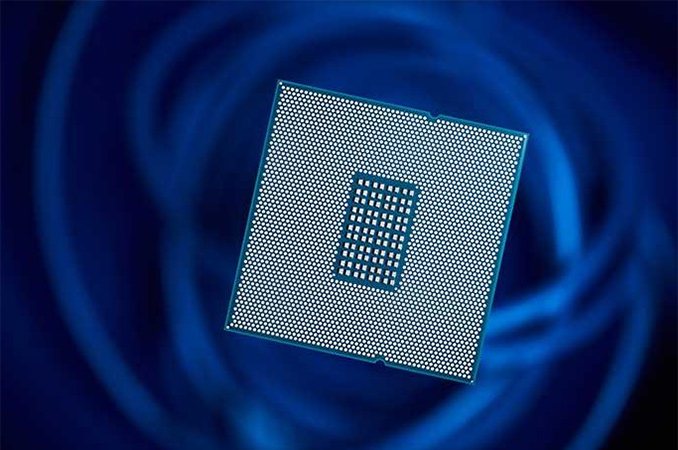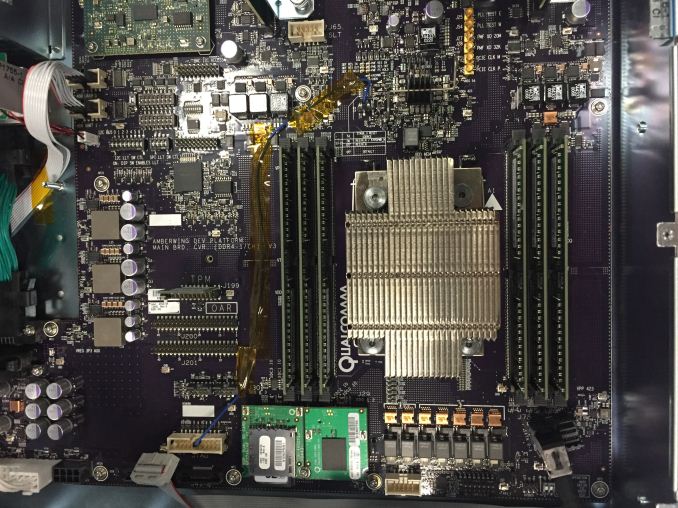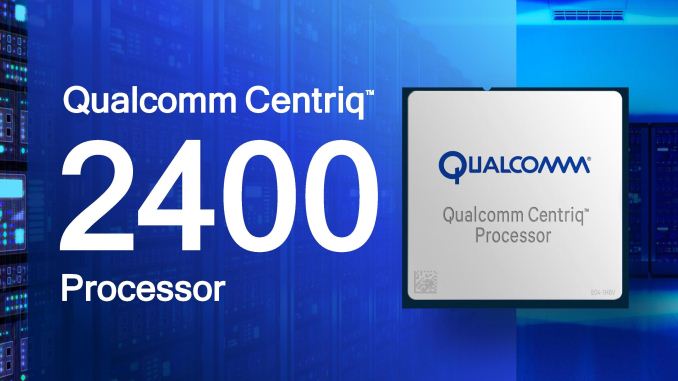Qualcomm’s Server Team Loses VP of Technology, Centriq Future Unknown
by Ian Cutress on July 6, 2018 2:00 PM EST- Posted in
- CPUs
- Qualcomm
- SoCs
- Enterprise CPUs
- Servers
- Centriq
- Centriq 2400

Normally we don’t particularly comment on these sorts of transitions at big companies unless they are C-level (CEO, CTO), however the narrative surrounding Qualcomm’s Centriq product line is still one that is perceived to be in flux. Qualcomm never commented on the rumors about its plans to find a buyer for Centriq, despite Axios and Bloomberg both reporting on them, and as a result never confirmed or denied the proposition: ultimately leading others to speculate. Followed by Anand Chandrasekher’s swift exit, again without public comment about reasons or replacement, and now another senior figure exiting the scene, brings more questions to the table than it answers.
The team behind Qualcomm Datacenter Technologies server platform, Qualcomm’s Centriq, has been in the news this past year as one of the key players in bring Arm architecture cores to the server and enterprise market. So far the time line looks like this:
- November 2014: Announced Plans to Enter Server Market
- December 2016: First 48-Core Demo and Sampling
- August 2017: Falkor Microarchitecture Detailed (Hot Chips)
- November 8th 2017: Cloudflare publishes integration testing
- November 10th 2017: Official Launch (for revenue) and Pricing
- May 8th 2018: Bloomberg Reports QDT may abandon Centriq
- May 13th 2018: Anand Chandrasekher, President of QDT, Leaves
- June 14th 2018: QDT Downsizing, 280 Jobs Cut
In 2017, Qualcomm announced the Centriq 2400 family of processors, built on Arm architecture cores at 10nm, for the enterprise and server market. This was meant to be the big break for Arm cores in the server market by a massive player that has the engineering staff and infrastructure to build a sizable customer base. The biggest version of the design implemented 48 of Qualcomm’s Falkor Arm v8 cores, paired with 60 MB of L3 cache, six channels of DDR4, running at a 2.2 GHz base frequency for 120W TDP and a price just shy of $2000: it was set to compete aggressively in the cloud server markets in performance per watt, overall performance, and cost. To date, Cloudflare has made the biggest noise about transitioning its DDoS protection platform from x86 to Centriq.

Qualcomm Centriq 'Amberwing' Development Platform, from Cloudflare
| Qualcomm Centriq 2400 Series | |||
| AnandTech.com | Centriq 2460 | Centriq 2452 | Centriq 2434 |
| Cores | 48 | 46 | 40 |
| Base Frequency | 2.2 GHz | 2.2 GHz | 2.3 GHz |
| Turbo Frequency | 2.6 GHz | 2.6 GHz | 2.5 GHz |
| L3 Cache | 60.0 MB | 57.5 MB | 50 MB |
| DDR4 | 6-Channel, DDR4-2667 | ||
| PCIe | 32 PCIe 3.0 | ||
| TDP | 120 W | 120 W | 110 W |
| Price | $1995 | $1373 | $888 |
However since the announcement, availability from the major server providers has been next to nil.
Back in May this year, almost at the same time as reports suggesting that Qualcomm was looking to offload (sell/close) the server processor division, Anand Chandrasekher left the company without much of a warning, at least publically, and aside from a personal tweet about leaving Qualcomm, no official note was given as to Anand’s replacement. The reports regarding the company offloading the server division were never confirmed, and behind the scenes several trusted sources reached out to AnandTech to say that this wasn’t really the case. Qualcomm has kept mum on the issue.
Fast forward to today, and another surprise hit our screens. One of the key members of the Falkor team, Dr. Dileep Bhandarkar, VP of Technology at Qualcomm Datacenter Technologies (QDT), seems to have parted from the company. Dileep was very much a key person for Falkor, purposefully spending time to track us down at Hot Chips after we published our detailed microarchitecture analysis and introduce us to the engineers, as well as chairing the Server Processor round of talks at the same event. The reasons for Dileep’s transition out of QDT are unknown. His departure was discovered due to his speaker biography for SemiCon West 2018 stating ‘formerly Qualcomm’.
Dr. Bhandarkar’s role is an important one here: he was a Director of Advanced Architecture at Intel for 12 years until 2007 (being a lead spokesperson for Intel’s server platform technologies), is an IEEE Life Fellow, has spent almost six years at Microsoft driving innovation and standards for its datacenters, and then a similar amount of time at Qualcomm working on technology strategy and business development, developing (among other things) machine learning accelerators currently in use at a major cloud provider. It would appear that rather than joining another industry behemoth, he is starting his own DNN based business.
So normally we don’t particularly comment on these sorts of transitions at big companies unless they are C-level (CEO, CTO), however the narrative surrounding Qualcomm’s Centriq product line is still one that is perceived to be in flux. Qualcomm never commented on the rumors about its plans for Centriq, despite Axios and Bloomberg both reporting on them, and as a result neither confirmed nor denied the proposition officially, ultimately leading others to speculate. Followed by Anand Chandrasekher’s swift exit, again without public comment about reasons or replacement, and now another senior figure exiting the scene, brings more questions to the table than it answers.
Whatever Qualcomm’s plans for Centriq have been, they seem to have stalled. It would appear that the product still does not seem to be available on the open market from the standard server manufacturers, and despite lots of talk citing the products wins over Xeon chips, nothing new has been said for quite a while. These OEMs are instead pushing Cavium’s ThunderX2 designs, which seem to have been gaining traction. Despite discussing with the Centriq team about being sampled for review in Q4 last year, that never materialized. Bloomberg also reported (via notices filed at a state level) a few weeks back that the company was cutting its datacenter unit in half, with up to 280 jobs on the line. It is possible that Dr. Bhandarkar's departure may have been one of these. The same report states that Qualcomm will continue its joint ventures in China, and rather than closing the unit will ‘persevere with a revised strategy’.
“Qualcomm remains committed to data-center opportunities and is not divesting the assets,” Amon said to Bloomberg. “We are reducing our investments in the data-center business but remain committed to our China JV and to refocusing our R&D efforts for upcoming compute opportunities.”
Source: SemiCon West













34 Comments
View All Comments
Yojimbo - Tuesday, July 10, 2018 - link
I think i explained what I meant by traction. It's getting the tires moving instead of just spinning in place. It's not rolling down the highway.Where has Qualcomm had large scale real world deplayoments? They had PR releases, exactly what you say these Cavium links are. The difference is that these are real, publicly verifiable systems. When Qualcomm and Microsoft or whoever else say that they are putting Centriq in the cloud that doesn't mean anything by itself. Even if they put them in publicly available instances. Take, for example, the AMD GPUs in.. was it AWS? I don't remember. Yes, that public cloud provider made public instances of AMD GPUs. But the number of them is almost meaningless compared to the number of NVIDIA GPU instances. Look at it from a business perspective in order to gain an insight on what it means. What these cloud providers want, most of all, is pricing power against Intel. That's why Microsoft and whoever else encouraged Qualcomm to pursue an ARM server chip. And making announcements about these chips is part of that pricing pressure. But real world HPC shops making real world systems has nothing to do with such a game. It definitely shows real world interest in the chips. Now, maybe there is some real world interest in the Centriq, but I personally haven't seen it yet.
As far as the deployments don't exist. You are wrong. They do exist. A 2.3 petaflops HPC machine isn't ordered and built over night. It was started years ago in some form or another. It will be delivered in the next few months.
Reflex - Tuesday, July 10, 2018 - link
CloudFlare deployed as did a few other edge providers. It wasn't enough and it was a lot more than what Cavium has done so far. Your definition of 'gaining traction' appears to be "announced a product and a single customer"....which I guess is some motion but seriously virtually every product gets that far.Yojimbo - Friday, July 13, 2018 - link
Uhh. I showed you 4 different HPC shops using the ThunderX2 in real machines. Almost no products get that far.peevee - Tuesday, July 10, 2018 - link
"There simply isn't a good reason to replace x68 in the server space at this time."Yes there is. Or rather ARE. System power/performance for one. Core density is another.
Modern x86 is not x86 or even 486 at all. The instruction set is so overloaded with "sometimes useful for some applications" stuff, the decoder has to be huge, meaning everything else does not scale down either without price/performance hit. For example, you practically have to have speculative OoO. Meaning the cores have to be big and inefficient to hit decent price/performance levels.
ARM (v8+) suffers from the same problem but not nearly as much, especially if you throw out all the 32-bit stuff as those server processors do.
Reflex - Tuesday, July 10, 2018 - link
The decoder hit for x86 is estimated to be around 1%. It's not a significant factor. ARM also uses speculative OoO (which is why Meltdown/Spectre hit ARM as well), it has nothing to do with how complex a core is and is about ensuring all cores are kept as busy as possible regardless of how poorly optimized the code is.The dirty secret is that ARM is not magically violating physics. As the capability of ARM based products have improved, price/performance has scaled to get closer and closer to Intel. At the same performance level in the same tasks they roughly use the same amount of power, assuming equally optimized code. Both architectures are very optimized for the tasks they perform, and as they add capabilities, core complexity, die size and power consumption rise, with die shrinks and power gating utilized to keep that rise from being linear.
iwod - Friday, July 6, 2018 - link
Why has Cavium’s ThunderX2 got traction, and not Qualcomm? Dual Socket Support?Anyway, Qualcomm's initial projection, and the revised projection, and now the 3rd and latest projection of ARM Server market shares has all but failed. And Given any Centriq deals for 2018 is done, and for most part 2019 deal has nothing much left.
Yojimbo - Saturday, July 7, 2018 - link
Cavium's current ThunderX2 is positioned in the compute segment, this Qualcomm chip is more in the storage segment. That could have something to do with it. Cavium also has the advantage of already being in the server components market. Qualcomm just had ties with Microsoft. Unless Microsoft was so impressed to buy lots of their chips they have to convince others they are willing and capable to serve the segment long term.peevee - Friday, July 6, 2018 - link
It is "Chandrasekher", not "Chandrasekhar".Ryan Smith - Friday, July 6, 2018 - link
Ack! There's an embarrassing error.You are correct. The article has been fixed.
Yojimbo - Saturday, July 7, 2018 - link
A report came out that Centriq was in trouble and Qualcomm denied it. Now this. Too many companies just lie, lie, lie to their investors. Next thing the head of Intel's 5G modem project is gonna be resigning.